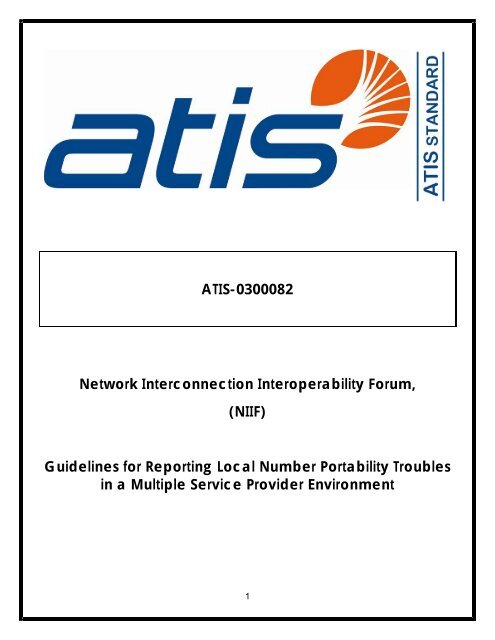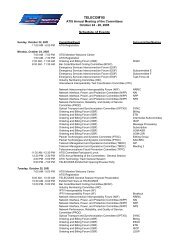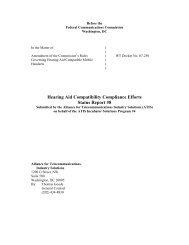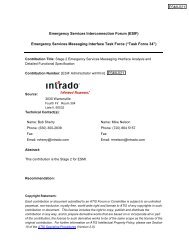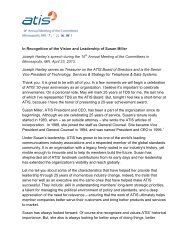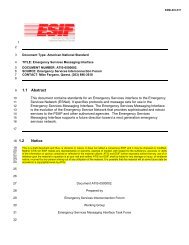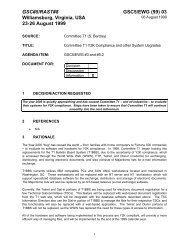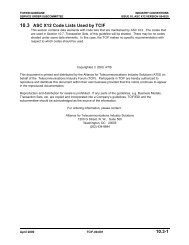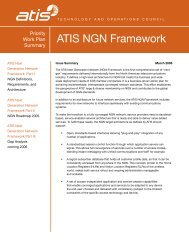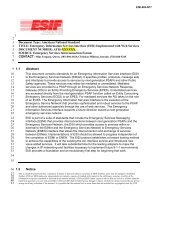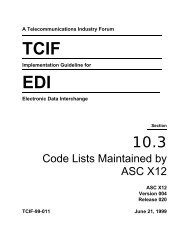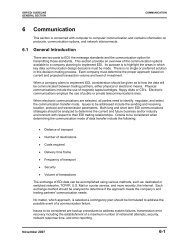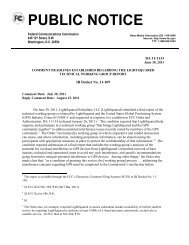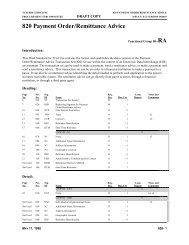Guidelines for Reporting Local Number Portability Troubles i - ATIS
Guidelines for Reporting Local Number Portability Troubles i - ATIS
Guidelines for Reporting Local Number Portability Troubles i - ATIS
You also want an ePaper? Increase the reach of your titles
YUMPU automatically turns print PDFs into web optimized ePapers that Google loves.
<strong>ATIS</strong>-0300082<br />
Network Interconnection Interoperability Forum,<br />
(NIIF)<br />
<strong>Guidelines</strong> <strong>for</strong> <strong>Reporting</strong> <strong>Local</strong> <strong>Number</strong> <strong>Portability</strong> <strong>Troubles</strong><br />
in a Multiple Service Provider Environment<br />
1
<strong>ATIS</strong> is a technical planning and standards development organization that is committed to<br />
rapidly developing and promoting technical and operations standards <strong>for</strong> the communications<br />
and related in<strong>for</strong>mation technologies industry worldwide using a pragmatic, flexible and open<br />
approach. Over 1,100 participants from more than 350 communications companies are active<br />
in <strong>ATIS</strong>’ 21 industry committees, and its Incubator Solutions Program.<br />
< http://www.atis.org/ ><br />
<strong>ATIS</strong>-0300082, <strong>Guidelines</strong> <strong>for</strong> <strong>Reporting</strong> <strong>Local</strong> <strong>Number</strong> <strong>Portability</strong> <strong>Troubles</strong> in a Multiple<br />
Service Provider Environment. Formerly NIIF 0004<br />
<strong>ATIS</strong>-0300082, <strong>Guidelines</strong> <strong>for</strong> <strong>Reporting</strong> <strong>Local</strong> <strong>Number</strong> <strong>Portability</strong> <strong>Troubles</strong> in a Multiple Service<br />
Provider Environment, is an <strong>ATIS</strong> standard developed by the NIIF under the <strong>ATIS</strong> OAM&P<br />
Functional Group.<br />
Published by<br />
Alliance <strong>for</strong> Telecommunications Industry Solutions<br />
1200 G Street, NW, Suite 500<br />
Washington, DC 20005<br />
Copyright © 2006 by Alliance <strong>for</strong> Telecommunications Industry Solutions<br />
All rights reserved.<br />
No part of this publication may be reproduced in any <strong>for</strong>m, in an electronic retrieval system or otherwise, without the prior<br />
written permission of the publisher. For in<strong>for</strong>mation contact <strong>ATIS</strong> at 202.628.6380. <strong>ATIS</strong> is online at < http://www.atis.org >.<br />
Printed in the United States of America.<br />
2
Table of Contents<br />
Introduction .......................................................................................................................... 4<br />
LNP Multiple Service Provider Environment ........................................................................ 5<br />
Considerations Prior to LNP Trouble <strong>Reporting</strong> ............................................................... 5<br />
Network Architecture............................................................................................................ 5<br />
Network Provisioning ........................................................................................................... 6<br />
Customer Provisioning......................................................................................................... 8<br />
In<strong>for</strong>mation <strong>for</strong> Trouble <strong>Reporting</strong> ........................................................................................ 9<br />
3
INTRODUCTION<br />
This document is intended as an aid in reporting and resolving troubles involving <strong>Local</strong><br />
<strong>Number</strong> <strong>Portability</strong>. This document is not meant to replace or supercede other NIIF<br />
agreements and procedures.<br />
Due to the complexity of LNP, problem resolution can involve ILECs, CLECs, IXCs and<br />
Wireless Carriers, as well as 3 rd party Database and Service Bureau Providers. This<br />
service relies almost exclusively on network element provisioning being per<strong>for</strong>med/timed<br />
correctly throughout all networks. Trouble reporting should be handled following<br />
processes and procedures developed by each entity. <strong>Troubles</strong> should not be reported to<br />
another entity’s field personnel directly. If order/repair processes are not followed, it is<br />
difficult to measure per<strong>for</strong>mance, trouble types, volumes or to initiate possible required<br />
billing.<br />
For the purposes of this document, SP-X is the “ported from/donor” network, SP-Y is the<br />
“ported to/recipient” network, and SP-Z is neither the “ported from” nor the “ported to”<br />
network, but may be another service provider(s) involved in the trouble report. SP-Z may<br />
be a long distance carrier network, another local service provider’s network or access<br />
tandem service provider network. There are procedures in the NIIF Reference Document<br />
<strong>for</strong> trouble reporting in a multiple service provider environment.<br />
SP-Z<br />
SP-Z<br />
SP-X<br />
SP-X<br />
SP-Y<br />
SP-Y<br />
555-1234 555-1234<br />
4
LNP MULTIPLE SERVICE PROVIDER ENVIRONMENT<br />
Each service provider should attempt to clear trouble within their network be<strong>for</strong>e referring<br />
trouble to another service provider. In a LNP multiple service provider environment as<br />
depicted above, responsibility <strong>for</strong> initiating a trouble report should be based on one of the<br />
following conditions:<br />
1. If ported customer(s) belonging to SP-Y report that they cannot receive calls from<br />
SP-X, then SP-Y should initiate a trouble report to SP-X.<br />
2. If customer(s) belonging to SP-X report that they cannot complete calls to ported<br />
customer(s) of SP-Y, then SP-X should initiate a trouble report to SP-Y.<br />
3. If ported customer(s) belonging to SP-Y report that they cannot receive calls from<br />
SP-Z, then SP-Y should initiate a trouble report based on NIIF guidelines <strong>for</strong><br />
dealing with trouble reporting in a multi-service provider environment.<br />
4. If customer(s) belonging to SP-Z report that they cannot complete calls to ported<br />
customer(s) of SP-Y, then SP-Z should initiate a trouble report based on NIIF<br />
guidelines <strong>for</strong> dealing with trouble reporting in a multi-service provider environment.<br />
5. If a “port-in-error” occurs between SP-X and SP-Y, and the customer has not<br />
reported the problem, the SP that identifies the problem should initiate the trouble<br />
report to SP-X.<br />
Additional scenarios related to IXC situations are included in this document as Appendix A.<br />
These scenarios may provide additional in<strong>for</strong>mation and guidance in resolving LNP trouble<br />
cases. Please note that the service provider nomenclature used in Appendix A does not<br />
con<strong>for</strong>m to the nomenclature in the body of this document.<br />
Considerations Prior to LNP Trouble <strong>Reporting</strong><br />
This section provides considerations to assist in the identification of an LNP trouble in a<br />
service provider’s network. These are not meant to be conditions <strong>for</strong> accepting a trouble<br />
report. The considerations listed have been grouped into three categories; Network<br />
Architecture, Network Provisioning and Customer Provisioning. It is important to be<br />
familiar with the content in all listed categories to aid in the successful identification of an<br />
LNP case of trouble and its resolution.<br />
NETWORK ARCHITECTURE<br />
The following bullet list represents network architecture components or activities that<br />
should be considered in the identification of LNP troubles:<br />
• LRN Database<br />
• Network Element Translations<br />
5
• <strong>Local</strong> Exchange Routing Guide (LERG)<br />
• NPA Splits<br />
• 1000 Block <strong>Number</strong> Pooling<br />
The following considerations are intended to further assist in isolating the cause of these<br />
LNP troubles:<br />
Interconnection Agreements are required to be in place to properly route calls.<br />
Inter Service Provider testing should be per<strong>for</strong>med with the service providers in the rate<br />
area to ensure seamless port capability to all customers.<br />
LNP network element failures, such as switch or LNP database could be causing the<br />
trouble.<br />
Switch LRNs and any portable NPA-NXXs should be populated in the LERG.<br />
Portable NPA-NXXs should be properly opened in all appropriate network elements,<br />
including End Offices, Tandems, Intermediate/Gateway STPs and Databases.<br />
End Office(s) database translations, routing, triggers and Location Routing <strong>Number</strong>s<br />
(LRNs) should be known and verified.<br />
Identify the involved SS7 and LNP network provider(s). (They may be different providers.)<br />
The ISVM/8XX/CLASS/LIDB services do not port with the telephone number and must be<br />
addressed by the “ported to” service provider. If the provider of these services has<br />
recently changed, associated Subscription Versions (SV) must be modified with the new<br />
point code and SSN as instructed by the new provider. These services may be provisioned<br />
by multiple providers and associated agreements must be in place.<br />
The access tandem should be capable of per<strong>for</strong>ming LNP queries.<br />
A non-facilities based reseller should contact their facility provider to determine if there are<br />
any network failures.<br />
Interworking (SS7-MF trunking) may result in LNP troubles. Non-SS7 trunks in the call<br />
path and the SS7-MF interworking functionality should be identified and verified.<br />
In the case of a recent NPA split, ensure that the portable NPA-NXXs have been properly<br />
provisioned in all appropriate network elements (end office, tandem, database, customer<br />
PBX, etc.).<br />
NETWORK PROVISIONING<br />
The following bullet list represents network provisioning components or activities that<br />
should be considered in the identification of LNP troubles:<br />
6
• Service Order Administration (SOA)<br />
• <strong>Number</strong> <strong>Portability</strong> Administrative Center (NPAC)<br />
• <strong>Local</strong> Service Management System (LSMS)<br />
• <strong>Local</strong> Exchange Routing Guide (LERG)<br />
• Access Service Request (ASR)<br />
• Firm Order Confirmation (FOC)<br />
• Provider Specific Provisioning Systems<br />
• NPA Splits (SOA/NPAC/LSMS/Provider Specific Provisioning Systems)<br />
• 1000 Block <strong>Number</strong> Pooling (Pooling Administrator Data Exchange/<br />
SOA/NPAC/LERG/LSMS/Provider Specific Provisioning Systems)<br />
The following considerations are intended to further assist in isolating the cause of these<br />
LNP troubles:<br />
Verify that the LERG reflects the accurate routing in<strong>for</strong>mation.<br />
Verify that an ASR was issued.<br />
Validate that the switch LRN(s) were created in the NPAC system.<br />
Verify that all portable NPA-NXXs have been populated in SOA/NPAC/LSMS/LERG<br />
systems.<br />
Verify that all required Destination Point Codes (DPCs) <strong>for</strong> services (CLASS/LIDB/ CNAM)<br />
been properly provisioned in all required network elements and are listed in the LERG.<br />
End offices experiencing error messages (Cause Code 26s) are a result of misrouted calls<br />
to a ported number. For example, in the basic call flow, if the end user re-ports without the<br />
necessary database changes, a call routed to the end user will fail.<br />
If more than one LATA is served from your switch, ensure that the LRN assigned is from<br />
the same LATA as the ported number.<br />
In the case of a recent NPA split, ensure that the new NPA-NXXs have been properly<br />
provisioned in all appropriate provisioning systems. If the NPA-NXX of a LRN was<br />
changed coincident with a NPA split, verify that the LRN has been changed and updated in<br />
the LERG and NPAC systems. Also verify that the active SVs associated with the new<br />
NPA-NXX have been updated in the NPAC system with the new LRN prior to the end of<br />
the Permissive Dialing Period.<br />
7
In a 1K block number pooling environment, ensure that blocks donated to the industry<br />
inventory pool are removed from appropriate provisioning systems to prevent duplicate<br />
number assignments.<br />
CUSTOMER PROVISIONING<br />
The following bullet list represents customer provisioning components or activities that<br />
should be considered in the identification of LNP troubles:<br />
• Inter-company Data Exchange Completion<br />
• LSR<br />
• FOC<br />
• Donor/New Switch translation<br />
• End Office Switching and Facilities<br />
• Activation/Broadcast<br />
• LRN<br />
• MRS (message relay service) Routing function<br />
• GTT<br />
• LIDB CNAM<br />
• ISVM<br />
• 1000 BLOCK NUMBER POOLING<br />
• ISPP (Intra Service Provider Port)<br />
• Block-holder contaminated verification<br />
The following considerations are intended to further assist in isolating the cause of these<br />
LNP troubles:<br />
Verify that the <strong>Local</strong> Services Ordering Guide (LSOG) process has been followed correctly.<br />
Verify that the <strong>Local</strong> Service Request (LSR) was issued and that the FOC was received<br />
be<strong>for</strong>e entering a service order activation transaction. If a FOC was not returned, the new<br />
customer may not be disconnected in the end office which will result in a “can’t receive<br />
some calls” report. The FOC provides some protection from ”slamming” accusations or<br />
inadvertent porting.<br />
8
Verify that the current status of the TN(s) is reflected correctly in the SOA system using the<br />
mechanisms available such as reports, history and query functionality. If the TN(s) has an<br />
incorrect status, then follow local methods and procedures to correct the status.<br />
SOA should ensure that the NPAC system is not in a sending mode on this activation<br />
be<strong>for</strong>e per<strong>for</strong>ming an NPAC system audit. If the NPAC system is in a sending mode <strong>for</strong> this<br />
activation, the NPAC system will ignore the submitted subscription in<strong>for</strong>mation and<br />
rebroadcast the last firm subscription data previously populated in the NPAC system.<br />
Verify that no NPAC system LNP provisioning failures have been received. If an LNP<br />
failure alert has been received, verify the data and resubmit the activation.<br />
Verify that the activation of the TN(s) has not failed to any or all LSMSs. Determine if<br />
failure or partial failure messages have been received from the NPAC system. If failure<br />
messages have been received, work with the NPAC to resolve those failures.<br />
At times, all LSMS databases are not synched. Verify the NPAC database by system<br />
query or call to the NPAC and analyze the results. To update an out of synch LSMS<br />
database, either request the NPAC to rebroadcast the subscription version or launch an<br />
audit from the NPAC system to the LSMSs. An NPAC system audit can download the<br />
in<strong>for</strong>mation it contains to all LSMSs and will update all provider databases. An NPAC<br />
system audit can also download the updated in<strong>for</strong>mation to a specific carrier if requested.<br />
If associated services (LIDB/CNAM/ISVM/CLASS) are provided, the ported TN’s SV<br />
in<strong>for</strong>mation in the NPAC database should include a gateway or intermediate destination<br />
point code, with corresponding subsystem numbers of zero or null value to prevent routing<br />
conflicts.<br />
A large TN port involving 20 lines or more should be handled as a coordinated cut or<br />
coordinated “Hot Cut”. If the trouble is related to a recent “large TN port”, then determine if<br />
all lines/services were verified with the customer after the port took place. This verification<br />
helps prevent “partial ports” or end users “ported in error”.<br />
Determine if the 10-digit trigger was originally applied in the donor switch. If the 10-digit<br />
trigger is not appropriate or applied, verify that the donor switch translations have been<br />
removed at the time of port.<br />
“Can’t be called” troubles may be the result of a Port to Original (PTO) (return to native)<br />
which has not followed documented processes <strong>for</strong> PTOs. A customer desiring to return to<br />
their original (native) switch initiates the process by contacting the native switch service<br />
provider, who completes a service order process to port to original. An order will be issued<br />
to disconnect the customer’s number from their end office translations and remove the<br />
number from the NPAC database. If this is not done, the customer will experience “can’t<br />
be called” troubles.<br />
INFORMATION FOR TROUBLE REPORTING<br />
In order to expedite LNP trouble reporting, a 24-hour, 7-day point of contact and telephone<br />
number is required <strong>for</strong> each company. This point of contact should be staffed by LNP<br />
9
qualified technicians. The NIIF maintains the National LNP Contact Directory, located at<br />
http://www.atis.org/atis/clc/niif/niifdocs.htm.<br />
SP-Y will be responsible <strong>for</strong> the acceptance of trouble reports from their end user. SP-Y<br />
should first test to determine if a trouble is in their network. If the trouble is found in their<br />
network, SP-Y will clear the trouble and no referral to SP-X is necessary. If the trouble is<br />
sectionalized by SP-Y towards SP-X, the trouble report will be referred to the SP-X. SP-X<br />
will clear the trouble or will work cooperatively with SP-Y to sectionalize the trouble where<br />
necessary.<br />
The following items are in<strong>for</strong>mation that is required by Service Provider’s LNP trouble<br />
reporting center and should be exchanged when handing off or referring the trouble:<br />
• Trouble Report <strong>Number</strong> Or Equivalent<br />
• Company Name<br />
• Service Provider ID (SPID(S))<br />
• Contact Telephone <strong>Number</strong><br />
• Contact ID (I.E., Name Or Initials)<br />
• Time And Date Report Was Received<br />
• 10 Digit Telephone <strong>Number</strong> Reported In Trouble.<br />
• Full Trouble Description.<br />
• Location Routing <strong>Number</strong>(S)<br />
• Old And New Provider And The Porting Date, If Available, If The <strong>Number</strong><br />
You Are <strong>Reporting</strong> Is Ported.<br />
• Full 10-Digit Telephone <strong>Number</strong>s (Originating And Terminating) Of The End<br />
Users Experiencing The Problem If These Are “Can’t Call” Or “Can’t Be<br />
Called” Reports.<br />
Additional in<strong>for</strong>mation that may be helpful when handing off or referring the trouble<br />
includes:<br />
• Tests Per<strong>for</strong>med And Results (If Requested)<br />
• Trunking ID<br />
• Non-Circuit Specific (Circuit ID May Not Be Appropriate)<br />
• Dispatch Authorization<br />
10
• Date And Time Of The Call If Known And Office CLLI Codes (Donor And<br />
Recipient Switches)<br />
• Home Tandem As Identified In The LERG<br />
• Results Of NPAC Audit<br />
• Call Type, e.g. O+, CLASS (*66, *69), Toll, Casual Dialing (101xxxx)<br />
• Call Origination (e.g., Inmate Facility Or PBX)<br />
• Other In<strong>for</strong>mation That May Be Of Assistance (e.g., History, Subsequent<br />
Reports)<br />
11
Appendix A<br />
Table of Contents:<br />
Scenario #1 Call Type:<br />
"N-1 Provider is missing subscription in the LNP Database" Page 1<br />
Scenario #2 Call Type:<br />
"N-1 Provider Does Not Have Translations to launch a LNP<br />
query to route the call" Page 2<br />
Scenario #3 Call Type:<br />
"N-1 Provider routes Call to Non-Serving Access Tandem" Page 3<br />
Scenario #4 Call Type:<br />
"N-1 Carrier Launches Second Query on LRN" Page 4<br />
Scenario #5 Call Type:<br />
"Failure of LIDB Service" Page 5<br />
12
Scenario #1: "N-1 Provider is missing subscription in the LNP Database LNP DB" NE database<br />
New SP-C<br />
SP-A<br />
IXC-A<br />
Network<br />
EO<br />
AT<br />
IXC<br />
AT<br />
Called Party<br />
LNP DB<br />
Old SP-B<br />
EO<br />
Call Fails<br />
EO<br />
Calling Party<br />
• Calling Party, SP-A, sends a call to IXC Network destined <strong>for</strong> the Called Party New SP-C.<br />
• IXC network is n-1 and does an LNP query.<br />
• The LNP database has no subscription <strong>for</strong> the dialed number and returns the original called number.<br />
• The call then goes to the Old SP-B AT.<br />
• The call is routed based on the called number because the FCI (Forward Call Indicator) bit is set indicating a lookup has<br />
previously been done.<br />
• The call then goes to the Old SP-B EO and fails because the called number is not working in that office. Because the FC<br />
is set, the end office will not launch another query.<br />
Page 1
Scenario #2: "N-1 Provider does not have translations to launch a LNP query to route the call.<br />
SP-C<br />
IXC-A<br />
EO<br />
Network<br />
SP-A<br />
IXC<br />
AT<br />
Called Party<br />
AT<br />
LNP DB<br />
Old SP-B<br />
EO<br />
EO<br />
If query is per<strong>for</strong>med at End Office<br />
If query is per<strong>for</strong>med at Access Tandem<br />
Calling Party<br />
• Calling Party, SP-A, sends a call to IXC Network.<br />
• IXC network is n-1 and does not have translations to launch a LNP query to route the call as expected.<br />
• The call is routed to the Old SP-B.<br />
• The Old SP-B per<strong>for</strong>ms a default query at the Access Tandem or the End Office.<br />
• The call is routed through the Old SP Network to the New SP-C network.<br />
• Call completes, but billing and access charges may be incorrect.<br />
Page 2
Scenario #3: "N-1 Provider Routes Call to Non-Serving Access Tandem"<br />
SP-C<br />
IXC-A<br />
EO<br />
SP-A<br />
Network<br />
LNP DB<br />
AT 1<br />
Old SP-B<br />
Called Party<br />
AT<br />
IXC<br />
AT 2<br />
EO<br />
EO<br />
Calling Party<br />
• Calling party SP-A, sends a call to IXC Network destined <strong>for</strong> New SP-C, called party.<br />
• IXC network is n-1 and per<strong>for</strong>ms LRN query.<br />
• IXC switch can route on LRN translations (6, 7, or 10 digit) or can use standard routing translations to route<br />
digits. If the LRN translations are directed to a tandem other than the tandem serving SP-C and , if SP-B doe<br />
call to be routed inter-tandem, the call will fail. Non-ported numbers will be routed using the standard routing<br />
• This is one specific scenario. There are additional variations to this scenario.<br />
If call is directed to the Non-serving Access Tandem<br />
If call is directed to the Serving Access Tandem<br />
Page 3
Scenario 4: "N-1 Carrier Launches Second Query on LRN"<br />
SP-A<br />
(n-1) IXC-A<br />
IXC<br />
IXC-B<br />
IXC<br />
SP-B<br />
AT<br />
AT<br />
LNP<br />
DB<br />
LNP<br />
DB<br />
EO<br />
Called<br />
Party<br />
Calling Party<br />
SCENARIO SETUP - IXC-A has POP’s to several LATA’s with their<br />
own facilities. However, several LATA’s are accessed via another<br />
carrier on shared facilities. Scenario 4 depicts this situation.<br />
Because, the outbound trunk group is not known until the LNP dip<br />
is returned, it is not possible to discriminate what calls are “dipped”<br />
and what calls are just <strong>for</strong>warded on. This is related to a vendor<br />
problem and is expected to be rectified in the future.<br />
Ca<br />
Calling Party, SP-A, dials 1+10 digits sending call to IXC-A.<br />
IXC-A launches LNP query as N-1 carrier. CdPN moved to GAP in SS7 message. LRN populated in CdPN of SS7 message.<br />
FCI populated in SS7 message since query has been per<strong>for</strong>med. Call <strong>for</strong>warded to IXC-B <strong>for</strong> termination to SP-B<br />
IXC-B ignores FCI, launches second query on number populated in CdPN (which is now the LRN). Query returns same LRN.<br />
LRN moved to GAP in SS7 message. LRN populated in CdPN of SS7 message.<br />
IXC-B terminates call to SP-B.<br />
Page 4
Scenario 5: Failure of LIDB Service<br />
SP-C<br />
LIDB<br />
Signaling path<br />
DB<br />
SP-A<br />
EO<br />
IXC<br />
Scenario setup:<br />
EO<br />
Calling<br />
Party<br />
LNP<br />
DB<br />
Call Fails<br />
• A customer ports his service from SP-B to SP-C<br />
• The customer is in SP-A area and places a LIDB 0+ calling card call to his home.<br />
SP-B<br />
LIDB<br />
DB<br />
EO<br />
Call Flow:<br />
• Calling Party dials 0+10 digits<br />
• IXC Transports LIDB query to LNP database to obtain GTT in<strong>for</strong>mation to route the LIDB query<br />
• The Point code and SSN in<strong>for</strong>mation is wrong and points the query to SP-B LIDB database<br />
• The LIDB response returns an error because the record <strong>for</strong> that subscriber is not in the database because it has<br />
moved to SP-C LIDB<br />
• Depending on SP-A’s response to the LIDB failure, the call may or may not complete<br />
Page 5
Page 5


